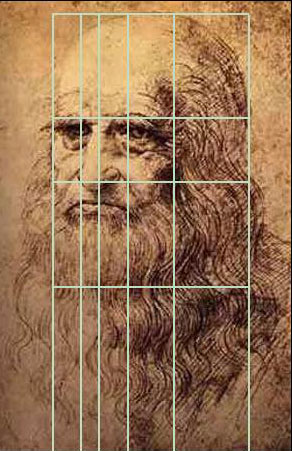How Golden is the Golden Section?
 Whenever I talk about proportion and harmony in art and architecture, many assume that I am referring to the proportion known as the Golden Section (often indicated by the Greek letter Φ). When I started to investigate these things, I assumed that the Golden Section was important too. However, to my surprise, my investigations lead me to believe that although it was known to past societies and cultures, it was not as important as we assume today. In fact, the idea that it was used by the ancient Greeks, the medievals or masters of the High Renaissance is, as far as I can work out, largely a myth. I have described in detail in my course, the Way of Beauty at www.Pontifex.University and in my book of the same name, how important symbolic number, proportion and harmony (expressed numerically or geometrically) was for artists and architects in the Christian tradition and how they were seen as a manifestation of the cosmic liturgy. But, surprisingly, it seems that the Golden Section, Φ, isn’t part of that tradition. It is proportion based upon the mathematics of music that was much more important. Most of the books that I read justify their argument with a diagram, like the one shown left. In this diagram a grid is placed over a copy of Leonardo's self portrait drawing. The grid, to my knowledge, is not taken from information given by Leonardo himself in regard to this drawing, but is a modern superimposition. To me it looks like an array different rectangles, no doubt all relating to to Φ is some way, but otherwise arbitrarily chosen until their combination coincides with the main features of the drawing...and not very well at that. The eyes, the mouth, the tip of the nose, the chin (which is hidden) do not coincide with the lines drawn. This misfit is typical. When you look at it, given the margin of error that required to make it fit, you could justify just about any proportion you chose to apply.
Whenever I talk about proportion and harmony in art and architecture, many assume that I am referring to the proportion known as the Golden Section (often indicated by the Greek letter Φ). When I started to investigate these things, I assumed that the Golden Section was important too. However, to my surprise, my investigations lead me to believe that although it was known to past societies and cultures, it was not as important as we assume today. In fact, the idea that it was used by the ancient Greeks, the medievals or masters of the High Renaissance is, as far as I can work out, largely a myth. I have described in detail in my course, the Way of Beauty at www.Pontifex.University and in my book of the same name, how important symbolic number, proportion and harmony (expressed numerically or geometrically) was for artists and architects in the Christian tradition and how they were seen as a manifestation of the cosmic liturgy. But, surprisingly, it seems that the Golden Section, Φ, isn’t part of that tradition. It is proportion based upon the mathematics of music that was much more important. Most of the books that I read justify their argument with a diagram, like the one shown left. In this diagram a grid is placed over a copy of Leonardo's self portrait drawing. The grid, to my knowledge, is not taken from information given by Leonardo himself in regard to this drawing, but is a modern superimposition. To me it looks like an array different rectangles, no doubt all relating to to Φ is some way, but otherwise arbitrarily chosen until their combination coincides with the main features of the drawing...and not very well at that. The eyes, the mouth, the tip of the nose, the chin (which is hidden) do not coincide with the lines drawn. This misfit is typical. When you look at it, given the margin of error that required to make it fit, you could justify just about any proportion you chose to apply.
My feeling is that today's overemphasis of the historical importance of Φ results from a modern, neo-pagan worldview in which the natural world is seen as the ideal of beauty. This is in contrast with the tradition Christian view that the world, although good and beautiful, is fallen and points us to something greater. The Christian interest has always focused more on what the created world ought to be, rather than what it is; and to what it points us to, that is the ultimate standard of Beauty, God.
I have found no historical evidence where contemporary sources say that Φ was used in the design of any building before the 20th century. It was known to the ancient Greeks, but I don't see anywhere that they considered a proportion of great beauty. I have seen plenty of analyses of old buildings by modern commentators which claim that their analysis of the dimensions of the building support the hypothesis, but the margins of error are so great that these claims are not credible to me. Moreover, there are other traditional proportions, for example those referred to by Boethius, Plato, and Augustine which would fit more closely and we do have evidence that they were used in the design of buildings from the pre-Christian era up to the early 20th century.
If we assume that I am right and that the use of Φ in the past has been exaggerated in modern accounts of art history. Does this mean that it shouldn’t be used today? In my opinion, not at all! However, if we do decide to use it, it should be done so with discernment. We need to consider what precisely we feel that it symbolizes and how it relates to the rest of the Christian tradition of harmonious proportion. If we consider it, for example, as a symbol of a fallen, imperfect world, then it should not be used in isolation, but should always be used in conjunction with other proportions that allow it, to use a musical terminology, to resolve to a more perfect harmony. The ultimate test of its value, however, is not the theory that justifies it, it is the beauty of the buildings that employ it.
I have described the reasons why I am so skeptical about the use of the Golden Section much greater detail in the chapter Golden or Fallen? in my book, the Way of Beauty.
My mind is not closed on the matter - if someone can produce an account from an architect of any historical period who describes how he used this proportion in his design, then of course I will change my mind!
